How to deal with diseases and pests of carrots
How can you tell if a carrot is sick? Spots, mold or rot appear on foliage and roots. The cause of this condition is bacteria, fungi or a virus. If a vegetable is bitten and has sticky marks on it, it’s time to fight pests. Only by defeating the disease and driving away pests can the harvest be preserved. Read our article on how to do this.
How to tell if carrots are sick
Carrots can get sick when grown in the garden, and mold can appear on carrots in storage. It is easy to recognize the disease even from a photo. If the appearance and shape of the leaves have changed, insects have appeared on them, the roots are damaged or have a strange shape - this indicates that the vegetable is unhealthy.
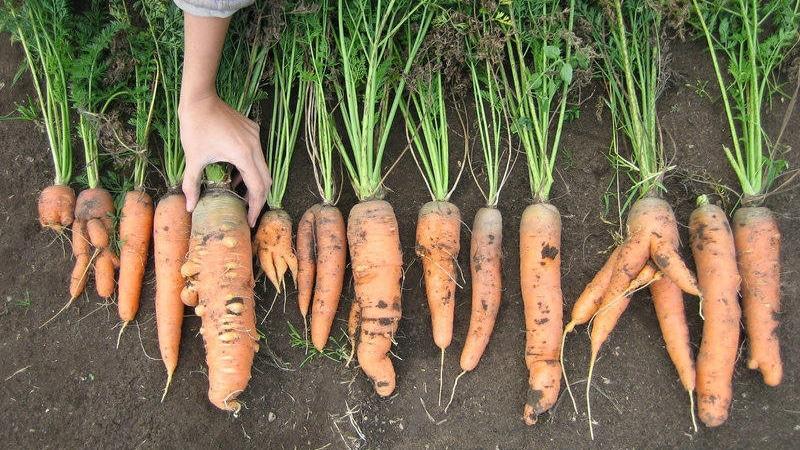
Signs and symptoms
Each disease has its own symptoms. The main signs of damage to carrots are on the green tops and petioles:
- blackening of the stem, constrictions on it;
- the appearance of spots of different colors on the stem and leaves - brown, gray-brown, yellow, black;
- bacterial exudate - gray-white or light yellow drops on the stem and lower leaves;
- darkening, curling, yellowing, drying of leaves, their death;
- plaque on leaves and petioles of any color;
- leaves and petioles are eaten.
Causes of diseases
Causes: damage by fungi, bacteria or viruses. At first glance, it is difficult to understand whether a vegetable is sick or has not been properly cared for. Methods of “treatment” of root crops depend on a correctly made “diagnosis”.
How to distinguish diseases from a lack of microelements and errors in cultivation and care
The main external signs that the cultivation is going wrong and the disease may soon affect the carrots: the carrots crack and look unappetizing, take on bizarre, ugly shapes or are poorly stored.
Let's consider the reasons:
- Excess nitrogen. Nitrogen fertilizers are applied a year before planting carrots, i.e. for crops that were planted before it.
- Irregular watering, sudden waterlogging. Proper watering of carrots: 2-3 times a week, so that the soil is saturated to 20 cm.
- Heavy soil, for example, clayey - it is difficult for root crops to germinate in it. If the soil is dense, the seeds will not sprout. Loosen the soil as soon as seedlings appear and after each rain or watering. The soil is maintained in a loose state throughout the growth of the carrots.
- Absence feeding. Taste quality deteriorates. To make carrots juicy, they are fed with “Nitroammophoska” - 25-30 g per m².
- Irregular watering and lack of loosening – causes of “hairiness”. If the carrots are covered with suction roots, they can be eaten, but they cannot be stored for long. The smoothness of carrots can be restored if errors in care are corrected. Then the suction roots will stop growing in all directions to get water and air.
- No hilling. If the top of the root vegetable becomes bare and begins to turn green, it means that solanine has formed in it, a poison that gives the vegetable bitterness. To avoid this, carrots are regularly hilled when the soil is moist. The first time is when the carrot’s tail breaks through and grows a little, and subsequently, as soon as the upper part sticking out of the ground is exposed.
- No thinning – the reason for low productivity. Carrots are thinned out after watering or rain.The first time - when two true leaves have grown, then - after two weeks. There should be 4-6 cm between shoots.
Interesting things on the site:
What are carrot diseases?
Carrot diseases are divided into three groups: fungal, viral and bacterial.. Sometimes they appear almost identical in appearance and differ only in one or two characteristics. Correctly identifying the pathogen means protecting the crop and soil from the spread of the disease.
Fungal
The largest group of diseases. They develop due to sudden changes in air temperature and high humidity. The pathogens spread quickly and live in the soil for a long time. Treat fungal infections in the early stages.
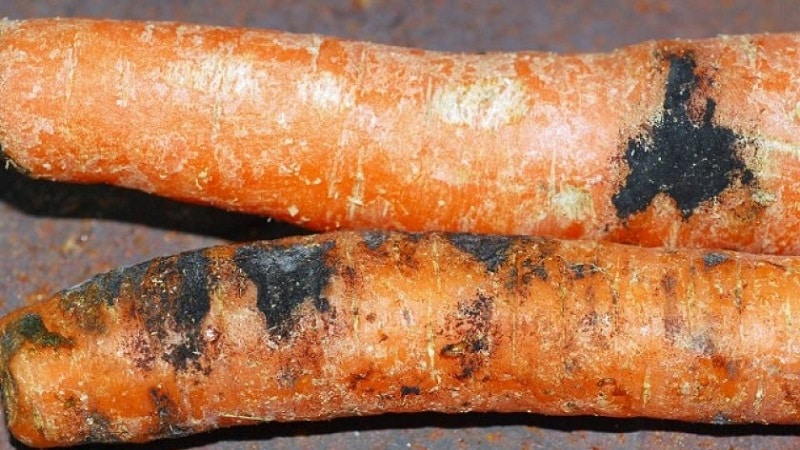
| Name | Signs |
| Dry rot, or phomosis of carrots | At the end of the growing season, oblong gray-brown spots form on the petioles and leaves. When storing crops at temperatures above 10°C, black-brown depressions with a white coating appear on top of the root crops. The spots grow and affect the entire vegetable. |
| White rot | It affects root crops, which soften during storage and become covered with a white fluffy coating. Later, a crust with black dots forms on them. |
| Felt rot, or rhizoctonia | Carrots are affected during the period of active growth or during storage. Dark gray spots form on root crops, which are covered with a purple felt coating and black dots. |
| Gray mold, or botrytiosis | During storage, the surface of the root crop becomes soaked, completely darkens and becomes covered with a gray coating. |
| Black rot, or Alternaria blight of carrots | Occurs at any stage of vegetable development.The stem becomes black, the leaves turn yellow, curl and dry, and black dry rot appears on the root crop. |
| Cercospora
|
Light brown spots form on the leaves, their light center grows over time. If the humidity is high, the leaves become covered with bloom, curl and die. The root crop remains small and no longer grows. |
| Powdery mildew | The disease develops due to high humidity in the air or soil. The tops turn yellow, and white dotted spots appear on its lower part. Then the stem dies, the roots become bent and remain underdeveloped. |
| Fusarium | It affects early varieties of carrots; the peak of disease development is the first half of June. The tops grow poorly and brown spots appear on the petioles. Root crops are twisted, with cracks. When storing infected carrots, a fluffy white-pink coating appears. Typically, such root vegetables are dense, dry and tasteless. |
| Brown spot | It affects vegetables at all stages of development. In young plants, brown constrictions appear on the lower part of the stem. Yellow spots form on the leaves of mature plants, then they turn brown or black. |
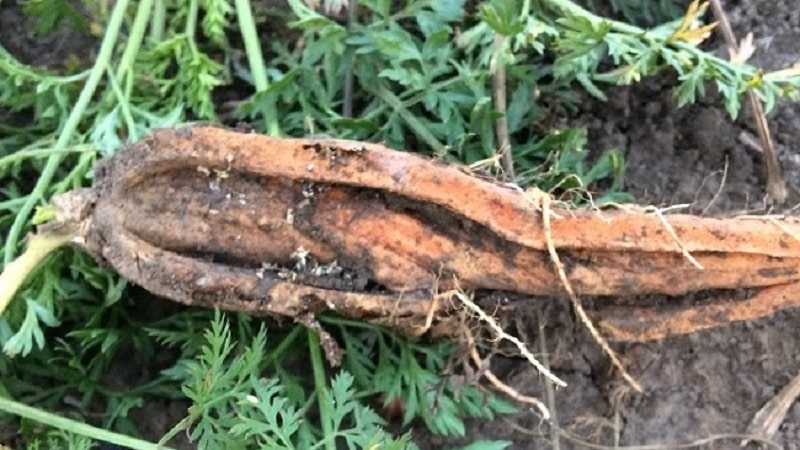
Viral diseases
The virus is most often found in southern regions. The disease is called "variegated dwarfism" and is transmitted through the willow-carrot aphid.
Signs of the disease are visible only at the 3-4 leaf development stage. The tops become distorted, stop growing, and become reddish. The plant stops developing. Root hairs form on the root crop, reddish spots appear, and lignification occurs. These carrots are not eaten.
Bacterial
Bacteria cause wet bacterial rot, or bacteriosis.. With this disease, yellow spots form on the lower leaves, then they darken, leaving yellow outlines around. Bacterial exudate is released at the base of the leaves: gray-white or light yellow smudges. Brown stripes or spots appear on the stem. Root crops become covered with ulcers and brown spots. The vegetable smells sharp and unpleasant.
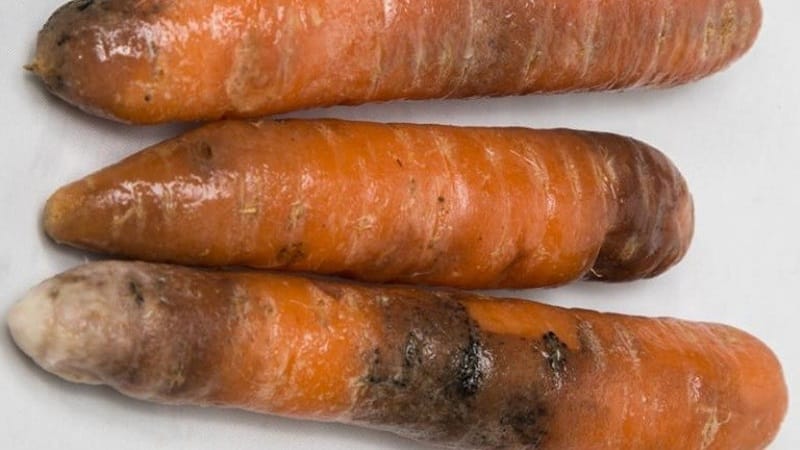
Carrot jaundice is considered a rare intermediate disease between viral and bacterial., which is carried by psyllids. The disease affects carrots from the moment they emerge. The leaves turn yellow, first turning yellow and then turning reddish-purple. There are many stems, but weak, the tops look like a “witch’s broom”. Lateral roots form on root crops. During storage they become soft.
Reference. Plant yellowing is caused by phytoplasma that invades plant cells and changes them so that they are more attractive to insects. This is how phytoplasma spreads through carrots, parsley, celery and other vegetables.
Disease control methods
Various methods of combating carrot diseases are successful - both folk and chemical.. Often gardeners have to look for the method that is suitable for a particular soil type and climate. We suggest that you familiarize yourself with each of them in more detail in the table.
| Disease | Folk method of struggle | Chemicals | Other |
| Dry rot, or fomoz | Garlic solution: The heads or shoots of the vegetable are chopped. Dissolve 1.5 cups of garlic in 1 bucket of water, leave for 24 hours, filter the solution, add 2 g of potassium permanganate. Spray at the first sign of disease of the plant or its neighbors. Then every 2 weeks. | Before planting, fertilize with a phosphorus-potassium mixture.Spray with 1% Bordeaux mixture at the first signs of disease. | All diseased plants are destroyed. |
| White rot | Mix crushed chalk with a strong solution of potassium permanganate: the consistency is liquid, the chalk should completely dissolve. Spray onto the plant with a brush. | For spraying, chemicals are used: copper sulfate, Bordeaux mixture, Hom, Rovral, Euparen multi or other copper preparations. 1 remedy – 1 season, otherwise addiction occurs. | Since the virus is transmitted from weeds, at the first signs of disease, thorough weeding is carried out. All infected vegetables are dug up and burned. |
| Felt rot, or rhizoctonia | The virus cannot be removed using folk remedies. | Before sowing, lime is added to the soil. The disease is treated during the period of active growth: sprayed with preparations containing copper chloroxide. | After harvesting, the root crops are carefully selected. All damaged and cracked ones are thrown away. |
| Gray mold, or botrytiosis | For a small number of gray rot foci, use a mixture of chalk (1 cup), wood ash (1 cup), and copper sulfate (1 tsp) per 10 liters of water. | Carrots are sprayed with 1% Bordeaux mixture - it helps even at the late stage of infection. The virus is also treated with fungicides, for example, Fitosporin-M. |
In storage, affected areas of root crops are cut off, and the remaining parts are sent for processing. The room is ventilated for 1-2 hours after cleaning. |
| Black rot, or Alternaria
|
When watering, add solutions of mullein or nettle. 1 kg of raw materials is placed in a large non-metallic container, 10 liters of cold water are poured. The mass is placed in the sun for 2 weeks and stirred daily. Before watering, dilute with water - 1:5.
|
They get rid of the disease by spraying with the drug “Rovral”.
|
|
| Cercospora
|
The shoots are sprayed with a solution of Bordeaux mixture.
|
The premises where carrots are stored are treated annually with lime and sulfur blocks. | |
| Powdery mildew | Dilute 2 tbsp in 10 liters of hot water. l. mustard powder, cool, sprinkle on the affected bushes, and the rest is poured under the roots. | After the carrots are collected, all plant residues are burned, the soil is dug deep and wood ash is added (200 g per 1 m²).
|
|
| Fusarium | 25 g of grated laundry soap are diluted in 1 liter of milk, 35 drops of iodine are added. Plants are sprayed with this product. | Affected plants are treated with fungicides: “Baktofit”, “Fitosporin-M”, “Trichodermin”, “Maxim”.
|
|
| Brown spot | The plants are treated with a decoction of pre-crushed celandine, horsetail or nettle. The grass is soaked in 10 liters of water, after an hour it is squeezed into the same water. After 3 hours, liquid or laundry soap and calcium chloride (1 ampoule) are added to the resulting infusion. Strain before spraying. | Solutions “Bravo” and “Quadris” perform well. Repeat treatment after 1-1.5 weeks. | |
| Variegated dwarfism | Plantings are pollinated with ash or tobacco dust. | The beds are treated with chemical insecticides: “Intavir”, “Karate”, “Iskra”, “Commander”, “Zeon”. | Coriander, garlic, basil, and mustard are planted between the rows.
The aphids that cause the disease are washed off with water. |
| Bacterial rot, or bacteriosis | Does not exist. | Spray the seedlings with the preparations “Hom”, “Fundazol”, “Yamato”, “Bayleton”. | Affected plants are removed and burned. |
| Jaundice | Does not exist. | Insect carriers are destroyed by washing them off with water. |
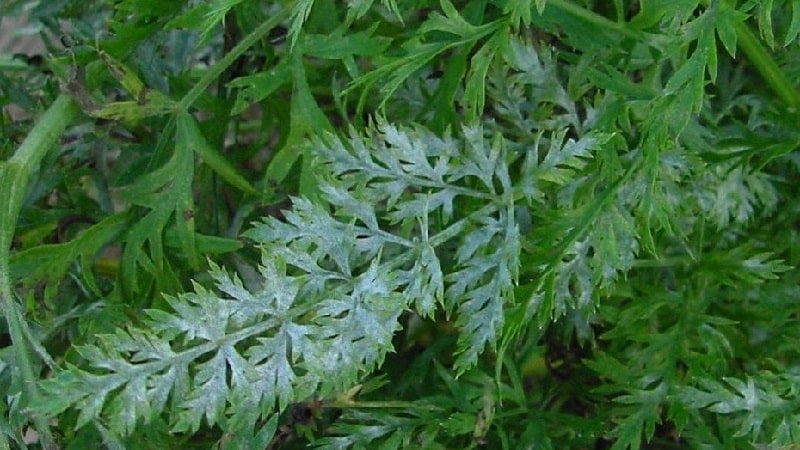
Prevention measures
The best way to fight diseases is prevention. By following the rules of planting, pre-planting preparation and care, you can avoid severe infections. and save the harvest.
Pre-planting treatment of the site and seeds
Pre-planting site treatment consists of applying fertilizers before sowing. They start in the fall, after the harvest has been harvested and a new place for planting carrots has been determined. When digging the soil, feed:
- sandy - scatter a bucket of humus and peat per 1 m²;
- loamy - pour half a bucket of sand and 100 g of superphosphate, lime and potash fertilizers.
After the work is completed, the soil is dug up and sifted, if after digging it has not become loose.
In the spring, before planting, they are embedded in the soil. nitrogen fertilizers (urea) or fertilizers containing nitrogen (“Cytovit”).
During sowing, sprinkle the beds with wood ash or dolomite flour.. Ash contains potassium and phosphorus, reduces soil acidity and protects against diseases. Mineral fertilizers are also applied: per 1 m² - 100 g of potassium fertilizer, 200 g of superphosphate and 50 g of sodium nitrate. All this is covered with lime for better absorption of fertilizers at the rate of 100 g per 1 m².
Carrot seeds are disinfected before sowing, then fungus and other diseases will not be scary for them:
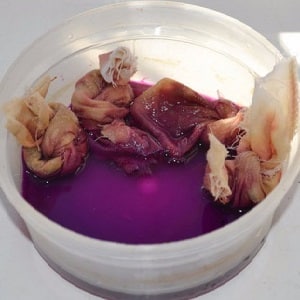 Soaking in a 1% solution of potassium permanganate. 1 g is dissolved in 100 ml of water, the seeds are placed there for 15-20 minutes, taken out, washed with clean water and dried.
Soaking in a 1% solution of potassium permanganate. 1 g is dissolved in 100 ml of water, the seeds are placed there for 15-20 minutes, taken out, washed with clean water and dried.- Use of biostimulants. The most famous is “Epin”: for one drop of the drug, take 50 ml of water at room temperature, keep the seeds for 2-4 hours, wash and dry until free-flowing. They also use potassium humate or sodium humate: add 100 ml of water to 1 g of powder - this is the mother liquor. One drop of it is diluted in 200 ml of warm water and the seeds are soaked for a day.
- People's recipe with aloe juice: a leaf of a three-year-old plant is wrapped in gauze and a bag and kept in the refrigerator for 2-3 days. Then the juice is squeezed out of it, 5-10 drops of which are diluted in a glass of water, and the seeds are placed there for a day. Do not wash off, dry and plant.
If you have purchased seeds, look for labeling indicating that they have been treated for illness on the packaging. There is no need to re-disinfect these seeds.
Take note:
Other techniques
The best way to protect carrots from diseases is proper care.. The plant needs to be provided with timely watering, loosening, hilling, weeding and fertilizing.
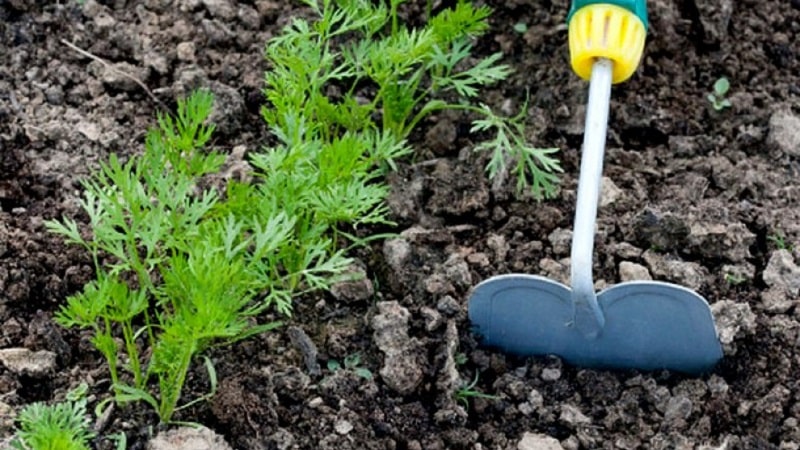
Proper care begins with planting: plant seeds in sandy soil to a depth of 4-5 cm, in clay soil - 1 cm. Carrots love warmth and sun. It should grow in open, unshaded areas. Ensure timely watering, loosen dense soil after watering or rain. Hill up for the first time when the carrot's tail has appeared and slightly grown. Then - as the top is exposed.
Attention! You can grow carrots in the same place after 2-3 years. Do not plant vegetables after lettuce and parsley - they have common pests.
Mineral fertilizers that are necessary for carrot growth and protection from diseases – nitrogen, potassium and phosphorus: “K-humate-Na”, “Crystallon”, “Sortvorin”, “Kemira”. They are not paid at once.
Important! It is necessary to get rid of weeds in the garden bed and between the beds. Weeds attract pests that spread to carrots and are carriers of fungal and other diseases.
What are carrot pests?
Pest control is carried out not only on carrots, but on the entire garden plot, treat all affected crops, weed the beds as they become overgrown. Only such a fight will save plants from damage and death. The table shows carrot pests in the garden and methods for controlling them.
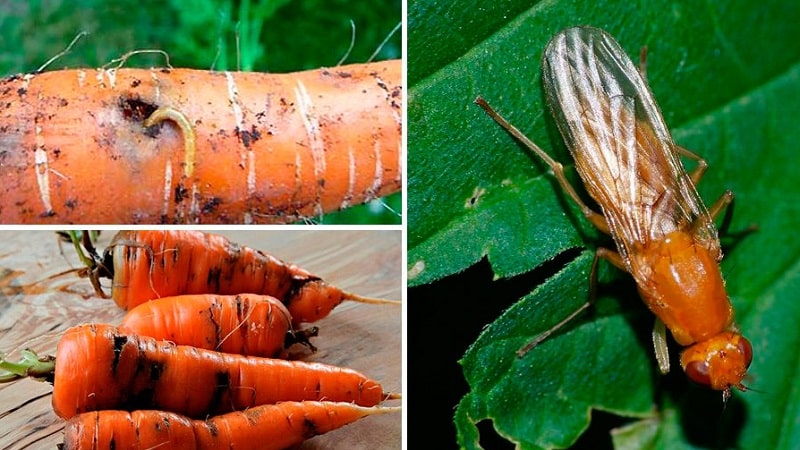
| Carrot pests and their descriptions | Signs of pest damage
|
Fighting methods |
| carrot fly. The pupa sleeps underground and turns into a small gray-brown insect. It is difficult to distinguish on carrot tops.
|
It feeds on root vegetables. The tops acquire a bronze tint, dry out and die. | Spray with chemicals “Shar Pei”, “Decis Profi”, “Aktellik” or pour over with pure ammonia.
|
| psyllid. The pest is transparent green in color. The wings and legs are like those of a flea. Females lay eggs on the tops so that the larvae feed on the sap of the leaves.
|
The larvae actively eat the foliage, causing the plant to dry out. | The eggs that appear are collected, the beds are treated with a soap solution or tobacco dust (400 g of the drug per 10 liters of water). |
| Umbrella moth looks like a brown butterfly.
|
Eats carrot fruit and weaves cocoons on the root crop. They drink vegetable juice before turning into a pupa. The tops darken, the root crop dries. | The seedlings are treated with Lepidocide or Entobacterin. |
| Naked slugs. They have a smooth grayish-pinkish or yellowish-white body with stripes or black spots. It is easy to recognize that slugs have appeared by the sticky shiny mark on the leaves and fruits.
|
Found where soil moisture is high. They eat leaves and eat holes in root crops. | The lime solution is mixed with 250 g of ash, 600 g of superphosphate is added and the soil is treated. |
| Wireworms – pale yellow worms 3 cm long, click beetle larvae.If there is a dark, striped, shiny beetle in your area that makes a loud clicking noise, it is time to exterminate it.
|
They feed on fruits, eating punctures in them. | How to deal with wireworms on carrots? Carrots are fed with ammonia fertilizers. The pest is destroyed with the drugs “Bazudin” and “Aktara”. |
| carrot aphid - a small green insect that completely clings to carrot leaves. | When there are aphids on carrots, the greens curl and dry out, and the carrot stops developing | Spray the plantings with infusion of tobacco, ash or soapy water (400 g of product per bucket of water). |
| Medvedka - a large brown armored insect. | Gnawing on carrot stems and roots. The plant dries and withers. Gnawed root vegetables are not eaten. | A mole cricket trap: manure is placed on the boards, and the mole cricket climbs in to live. After two weeks, the pile is burned along with the pest. The chemical method of control is the drug “Medvetox”. |
| Root nematode - a small worm-like insect. | It invades carrots and forms ugly growths on them. | Treat the soil with the anthelmintic drug “Dekaris”. |
| exclamation scoop. Looks like a brown butterfly. The vegetable is destroyed by caterpillars that lie in the ground before pupation. | It feeds on the root part of stems and root crops, making passages and holes in them. | They are destroyed with chemicals “Decis”, “Polytrin” and “Fury”, sprayed with infusions of burdock and chamomile (two packs of the prepared mixture per bucket of water). |
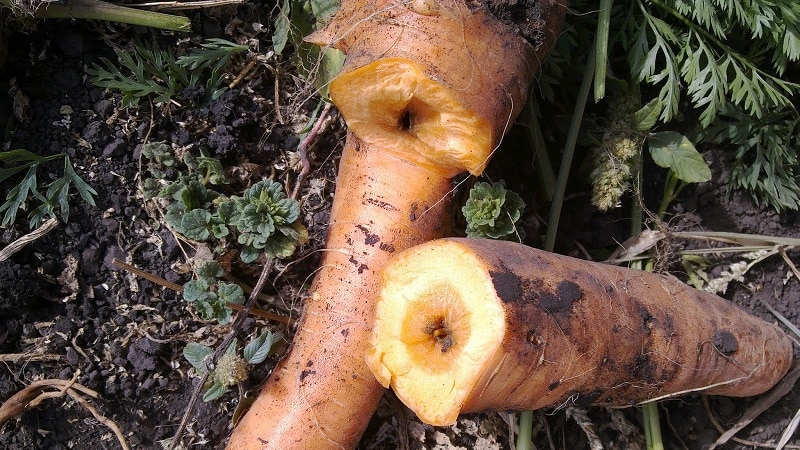
Prevention measures
To defeat pests that live underground, the soil is dug up twice: in the fall and in the spring, before planting, about one and a half times. All pests that have been hibernating since the fall will appear on the surface and die.And in the spring, once again loosening the soil, they kill not only the emerging pupae, but also create good conditions for the growth of the vegetable.
To prevent pests from appearing on the tops, remove weeds from the garden beds and between rows in a timely manner. If they were not affected, they are sent to compost, and if they were damaged, they are burned.
Why do carrots sometimes grow yellow instead of orange? The reason is poor quality planting material. It is recommended to plant seeds purchased from reputable stores.. If you are sure that seeds collected from your site carrots are not infected, plant them, but be sure to treat them before planting.
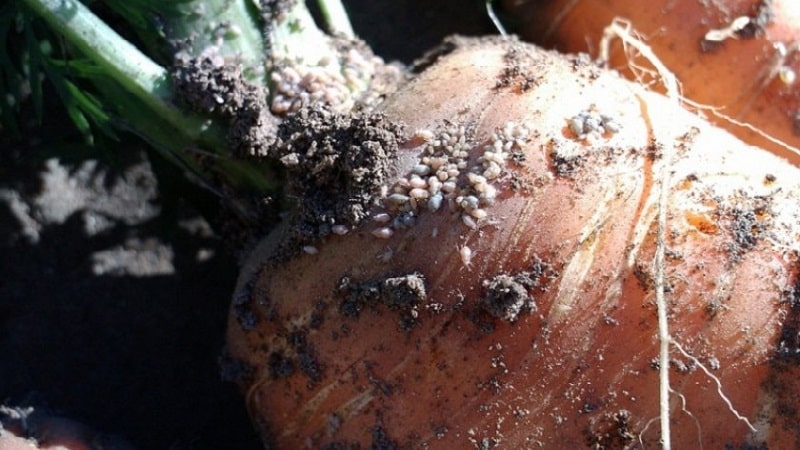
Chemical method of soil treatment for the purpose of prevention, it consists of two phases:
- When 4-6 carrot leaves appear, treat with ATO Zhuk (3 ml per 10 liters of water).
- When 6-9 leaves grow, they are treated with the drug “Fas” (4 ml per 10 liters of water).
Recommendations and advice from experienced gardeners on how to grow the best harvest
Every experienced gardener has 10-20 tips on how to get the best carrot harvest. Here are the main ones:
- In the spring, before sowing, the beds are not only dug up, but also furrowed to make the soil more lush. Carrots will not grow well on leveled, dense soil.
- Carrots are a vegetable that is eaten even when unripe. During the first thinning, the fruit will be quite juicy and will be used in salads and soups.
- To repel pests, marigolds or calendula are planted around the perimeter of the beds. Under no circumstances should parsley, dill and lettuce be planted.
- Fertilize according to a strict schedule. How can you treat carrots? Nitrogenous fertilizing is applied to the soil in early June - growth will accelerate and the carrots will hurt less.The next fertilizer is phosphorus, so that the root crop becomes stronger, sweeter, harder and does not dry out. Potassium fertilizer is applied in the middle of growth. The carrots will have a mild taste and will retain freshness for a long time.
Conclusion
Growing carrots is not easy. This vegetable is finicky and will not grow without proper care. If you let its cultivation take its course, it may get sick or suffer from pests. To cure the affected plant, determine its disease and use proven traditional methods or use chemicals.